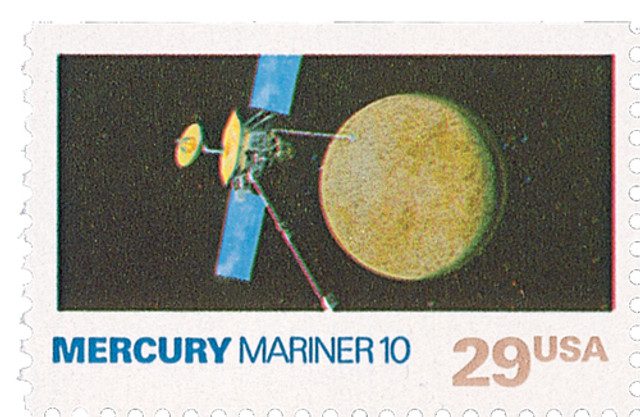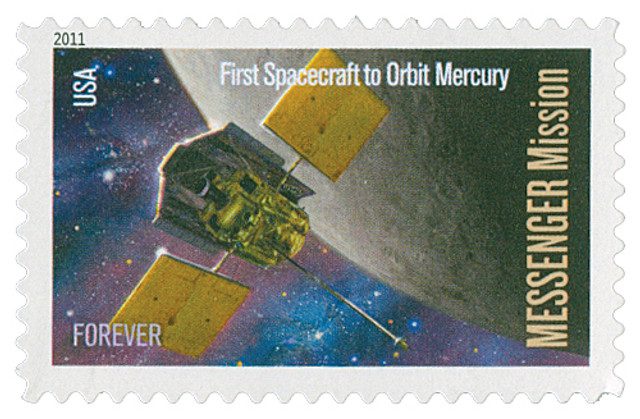On March 29, 1974, Mariner 10 became the first space probe to fly by Mercury.
NASA launched the Mariner program in 1962 to build and send probes to investigate Mars, Venus, and Mercury. Prior to the launch of Mariner 10, earlier missions explored Mars and Venus.
Because Mariner 10 was destined to orbit Mercury, the planet closest to the sun, scientists faced new challenges in its design. The probe would have to withstand 4.5 times more solar radiation than when it departed Earth, requiring extra shielding to protect it. Mariner 10’s designers installed thermal blankets and a sunshade on the main body and made the solar panels adjustable so they wouldn’t overheat.
Mariner 10 was also the first spacecraft to use an interplanetary gravitational slingshot maneuver. In doing so, it would use Venus’ gravitational pull to bend its flight path into Mercury’s orbit. This would also put Mariner 10 in an orbit that would repeatedly bring it back to Mercury. In order for this to work, Mariner 10 couldn’t change its trajectory more than 120 miles, so mission planners stocked the probe with three times the amount of fuel as previous models. This would also allow it to make two additional flybys.

The probe was fitted with a number of instruments to gather information to send back to Earth. These included several cameras, which used more power than all the other instruments combined. There was also an infrared radiometer to detect infrared radiation given of by both planets, which would help scientists to calculate their temperatures. Ultraviolet spectrometers were included to test whether Mercury had an atmosphere and to study the interstellar background radiation of Earth and Venus. Plasma detectors were added to study gases in the solar wind and observe Mercury’s magnetic field. However, a part of the probe didn’t open correctly, so not all of this information was collected. There were also charged particle telescopes and Magnetometers, both of which also studied Mercury’s magnetic field.
Construction on Mariner 10 was completed in June 1973, after which it underwent testing. After Mariner 10 completed it’s testing, NASA had a one-month window to launch it. They selected November 3, as it would provide the best imaging conditions when Mariner 10 was supposed to reach Mercury. The probe was launched that day at 12:45 a.m.
After a partial orbit of Earth, Mariner 10 was set on its path toward Venus. In its first week in space, Mariner 10 took five photomosaics of Earth and six of the Moon. It provided some of the best photos up to that time of the Moon’s North Pole region.
The journey to Venus was filled with technical malfunctions. According to one NASA scientist, “It seemed as if we were always just patching Mariner 10 together long enough to get it on to the next phase and next crisis.” Flaking paint repeatedly interrupted tracking and the on-board computer frequently reset itself. Mariner 10 approached Venus on February 5, 1974. Though several other probes had reached the planet before, Mariner 10 was the first to successfully send images back to Earth. The probe then dropped its velocity, setting it on course to orbit Mercury.
Although it experienced difficulties along the way, Mariner 10 finally reached Mercury on March 29, 1974. It was the first of three flybys (the others on September 21, 1974, and March 16, 1975) that revealed a wealth of information about the planet. Photographs revealed that Mercury looked a lot like our moon, with bare ground and lots of craters. It differed from the moon, though, by the presence of “scarps”, markings which suggest that the planet’s crust had shrunk at some point in its history. The probe’s tests also revealed that Mercury has a small magnetic field – about 1/60th as strong as Earth’s. Mariner 10 also detected a faint helium atmosphere and a large iron-rich core. The probe’s findings estimate that Mercury has a nighttime temperature of -297º Fahrenheit and a daytime temperature of 369º Fahrenheit. Because of its orbit, Mariner 10 photographed the same side of Mercury on each flyby, so the 2,800 photos only capture about 40-45% of the planet’s surface.
On March 24, 1974, shortly after Mariner 10’s final flyby of Mercury, its transmitters were turned off. Though the probe has run out of fuel, scientists believe it could still be orbiting the Sun today. The information gathered by Mariner 10 led to even more questions, many of which were answered with the launch of the MESSENGER probe in 2004.
Click here to see some of the images captured by Mariner 10.
Discover what else happened on This Day in History.



Believe its final flyby was March 16, 1975
Very good information for nonscientific reader. Its old but always new information. God’s creation is unfathomable. Thanks to NASA scientists for trying to reveal the mysteries of universe. The lonely planets in the universe must have a purpose.
Space exploration went from science fiction to reality in my lifetime. From the V-2 to Mariner 10 and beyond. The best of mankind’s efforts.
A very enjoyable digest of our first steps in the development of unmanned space exploration in early 60s, at the same time as Apollo’s manned mission to the moon were in its first planning stages. Not sure however whether one would want to link the production of V2 rockets (nazi instrument of terror/revenge raining death all over London-Antwerpen-Liege during WW2), and the Mariner peacetime programme, except perhaps that Herr Wernher von Braun was probably the main driving force involved in making both a reality. GdR
Liked the tidbit when reading about #2568, the 29cent Mercury stamp, when released and promoted by Mr. Spock of Star Trek fame, to highlight 1991’s National Stamp Collectong Month.
A great article on space and our involvement in learning more about the universe. The photos of the planet Mercury were also very interesting. Thanks again, Mystic … and GOD bless you guys !!